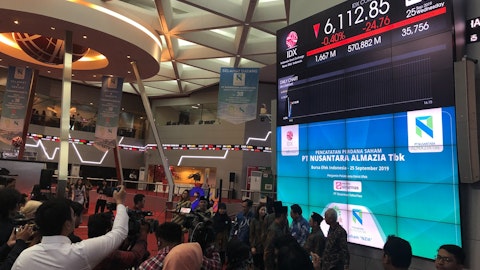Erik Engstrom: Maybe Nick will take the first one as a follow-up to the price question.
Nicholas Luff: Nick, you have to ask other companies what they — when they talk about price and exactly how they describe it. But I think the point for us is it’s about each customer taking more modules, taking more analytics and taking up more of our content sets and so on. So that should lead to an overall increase in spend on that individual customer, but we wouldn’t regard that as price they’re getting more value for the additional spend. So that’s how we would characterize it.
Erik Engstrom: So if you go on to risk, I would say, basically, as expected, we saw last year towards the end of last year, continued improvement, both in new sales and in activity levels in Business Services. So Business Services growth rate within Risk have gradually been coming up over the last few months and it continues that way in the beginning of this year. And as you said, they are actually now like in a slightly less strong growth period in early 2023. So we expect that to continue. And then, on the other hand, Insurance that had that ramp up towards a late — towards the end of 2022 and grew very strongly during all of 2023, they are now starting to lap at a time when they grew a little more strongly than they have in the past.
So we would expect that the overall growth rate on top of that now maybe then moderates down towards historical averages relatively soon. And that’s exactly what has happened over the last month or two. And as a whole, that division, therefore, continues to grow, almost exactly in line with what we had expected and what it has done at this time of year, most years when they had a good year. So it’s on track for what we expected. And as you said, slightly moderating in one and slightly accelerating in the other. The last part, you asked about Lexis+ AI. And yes, we are seeing very strong interest, very strong uptake. We had many thousands of law firms signing up for the initial sort of commercial insider program. We had certain advantages and certain previews and test and other.
And since it’s gone commercial, we have seen many firms signing up fully with large and wide deployment and significant step up in usage, and we’ve seen some others that have done small and initial tests, but it’s a full range and it’s very active out there, very active, it’s very positive. And the feedback we are getting is very good and we’ve gotten some very specific reports on how much they estimate they save in time and effort and so on that are, of course, very feature-specific and function specific and very private, but, to each firm. But it is very positive, and we have basically a full range of the alternatives that you mentioned. It is not one that’s dominating.
Operator: The next question comes from the line of Tom Singlehurst with Citi.
Tom Singlehurst : Yes. Tom here from Citi. Three if it’s okay, two on AI and one on Semantics, I think is probably the right word. But on AI, Lexis+ AI you’ve talked about. You’ve also launched Scopus AI within STM and one of the webinars you hosted explicitly said that it was an add-on charge for product. I’m just wondering whether you expect that to have a distinct positive impact on STM growth in 2024 or whether it will just take time to sort of work through in the same way that you described the impact at Lexis. The second question on AI is around investment. Publicists have said they’re investing EUR 100 million a year, WPP GBP 250 million a year, Thompson Reuters more than $100 million a year. Can you quantify the investment that you are making or have made and whether there’s any incremental spend on AI beyond the existing R&D budgets?
Second question. And then thirdly, I just really wanted to go back to that point you just made, Erik, on sort of historical trends because all the way through last year, there were constant references to historical trends, either you grow above them or in line with them. I suppose I’m just trying to get a sense of whether you are signaling that we’ve had a period of above-trend growth and we’re going to be slowing down or whether the new level, the new base that you set in 2023 is the new normal. Those are the three questions.
Erik Engstrom: Yes. I’ll cover the first and the third, but maybe I’ll cover the first and ask Nick to do it in order here, right? On AI, yes, we have several initiatives in STM. The ones that have been announced to the market would be the Scopus AI, which was announced last summer and then launched commercially recently. And we had, of course, CinicalKey AI, which was announced now a couple of months ago. And the difference between the Legal division and the STM division, is that the Legal division has a main core platform that’s being used across over 60% of the customer base, maybe even more over time and that core platforms then leverage internationally, and we put feature and functionality on top of that or embedded in a fully integrated platform.
So that Lexis+ AI is an integrated platform that then would have feature and functionality launches within it. STM has — even though it’s technically behind the scenes, the same infrastructure is that has several different and separate products that are sold to the market that then have their own AI tool kit on top. And they will, therefore, be brought to market at different times and separately, which means that any one of those will have a smaller impact on the commercial progress of the division individually. But of course, taken together over time, it’s going to be a significant positive impact. But so if you look at Scopus AI specifically, it’s a very sophisticated high-end embedded research platform tool and it is not covering a large part of the STM division.
So therefore, its impact commercially to us is going to be gradual and will take time to come through and drive any impact on revenue growth for the division. But the customer feedback has been very positive. The customer interest has been very high. We have had a very high number of customers engaged with us on this platform over the last few weeks on different types of introductory calls and presentations we have had, but it’s going to be gradual and it will take time to have a commercial impact.
Nicholas Luff: Tom, your second question on investment, et cetera, and AI. Look, we are always, of course, spending on and investing in adopting new technologies, either AI or anything else, building new data sets, building new products. And generative AI is obviously a significant opportunity, particularly for Legal, but also for STM as we’ve been discussing. But what we’re putting into it and behind it is really where are we directing our resource, where are we directing our spend and it’s not really changing the overall amount that we’re spending and putting behind the growth opportunities. And of course, the other thing generative AI gives is internal opportunities to make ourselves more efficient, our internal processes, and we’re obviously working on that as well.
So when you put all that together, we are obviously bring a lot of focus and effort into the generative AI opportunities, but that doesn’t change our overall approach of ensuring that cost growth gains below revenue growth in all of our businesses as we go forward.
Erik Engstrom: On the third question, the fact that we have now stopped referring to historical trends in our comparisons is an accurate observation, of course. We have used the reference to historical trends a few times for several years now. But we have stopped doing that because the company has now had several years of our improving growth trajectory in both revenue and profit. So the question of what we are referring to when you say historical trends have become less clear to some of our observers. So we moved off of that and instead focus on describing our growth objectives very clearly, overall, as well as by each division. And then in the guidance, in the outlook for each year, describing what we see for that year very precisely, so that it’s clear the range of growth we expect right now.
But just to make sure that it’s clear, we do not expect the improving long-term growth trajectory to stop or reverse. Our objective is to continue on this improving long-term growth trajectory, which is driven by the shift in business mix that we’ve talked about. But if you then bring that down to each division, we say that for the Risk division is to continue to drive strong growth in the current range for STM and Legal to continue on this improving growth trajectory, Legal will be gradual primarily subscription, it will come in over time and for Exhibitions to now operate in the higher growth — higher value, higher growth and higher margin environment that they have now ended up in after the pandemic redefined that business.
Operator: The next question comes from the line of Steve Liechti with Numis.
Steve Liechti: Yes, good morning, everybody. I’ve got two, please. First of all, on the STM for database and tools, I know you put it together in your commentary with corporate primary research. But can you give us a harder figure for STM database and tools as a percentage of that division? Maybe this year and last year. I’ve got 40% in my head, but I just wanted to confirm that. That’s the first question. And then on Exhibitions, you kind of mentioned it there actually in your last comments on sort of faster long-term growth rate. And given the business as it is structured now today, what do you think would be a good like-for-like growth rate going forward from here? Again, in my head, I’ve got 5% to 6% organic growth historically was kind of the right number for you in the old days.
Nicholas Luff: So the first question on what proportion is database and tools, it’s just under 40%. And then if you put in corporate primary research as well, you got to towards 45%.
Erik Engstrom: And on Exhibitions, I’ve said this before that in the near term on Exhibitions, we are 100% focused on sort of capturing the growth opportunity that exists there, which has here was the reopening as well as other opportunities. But now and going forward for the next few years, that we’re really 100% focused on the growth opportunity and the value uplift we see from the introduction of new data-driven digital tools and the commercialization of that. But it’s very clear to us now that Exhibitions is on track to become a higher value add, higher growth and higher margin business going forward than it was before COVID. I mean it’s going to be higher value add based on the fact that we are introducing a range of digital tools, and we have increased the rate of innovation, the pace of innovation in that business now.
It’s going to be higher growth based on the improving ability that we have developed to commercialize this higher value add, and it’s going to be higher margin based on the structurally lower cost base that we now have in the business. So that’s the direction that we are going. Exactly how big that value uplift will be, exactly how much higher the growth rate will be, I guess we will see over the next few years. But it’s going to be all of those three. I think that’s pretty clear to us. But I would assume the next few years, it’s going to be higher than it was before COVID or the numbers you mentioned.





